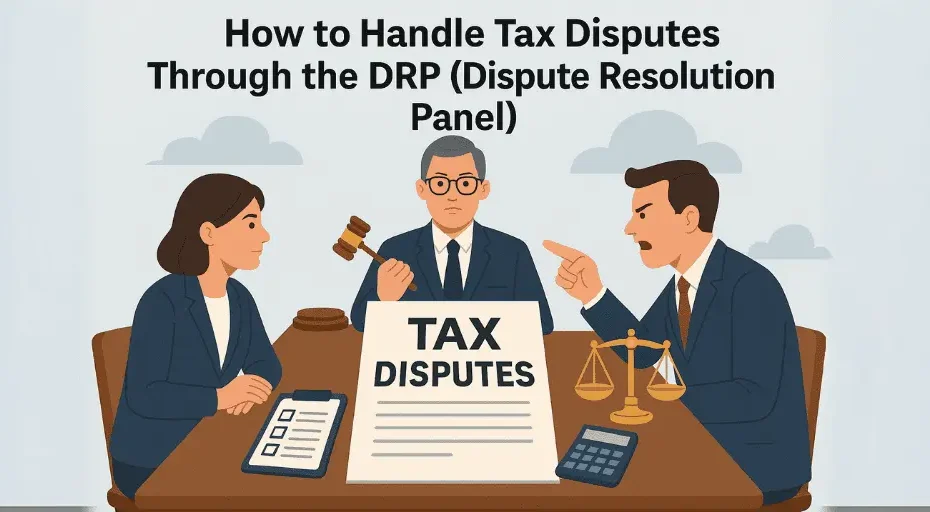How to Handle Tax Disputes Through the DRP (Dispute Resolution Panel)
Tax disputes between taxpayers and tax authorities can be time-consuming, expensive, and complex. To simplify and expedite the process, the Income Tax Department of India has introduced a specialized mechanism known as the Dispute Resolution Panel (DRP). Designed primarily for foreign companies and transfer pricing cases, this panel plays a vital role in resolving disputes swiftly and fairly. If you’re facing a tax assessment that you believe is unjust, understanding how the dispute resolution panel works can save you time, stress, and significant costs.
This blog explores the complete process of handling tax disputes through the dispute resolution panel, its benefits, eligibility, and practical tips for effective navigation.
What Is the Dispute Resolution Panel (DRP)?
The Dispute Resolution Panel is an alternative dispute resolution mechanism established under Section 144C of the Income Tax Act, 1961. It aims to resolve disputes arising from variations proposed in the draft assessment orders issued to certain eligible taxpayers—mainly foreign companies and cases involving transfer pricing.
The dispute resolution panel is composed of a collegium of three Commissioners of Income Tax (CITs). These officers are tasked with independently reviewing the objections raised by the assessee against the draft assessment order and issuing directions for final assessment.
Why the DRP Was Introduced
The primary reasons for introducing the dispute resolution panel include:
Speedy Resolution: Traditional tax litigation in India can take several years. The DRP provides a faster way to resolve disputes.
Avoidance of Prolonged Litigation: It serves as an intermediary step before moving to the Income Tax Appellate Tribunal (ITAT).
Independent Oversight: Since the DRP is separate from the Assessing Officer (AO), it offers an objective perspective on disputes.
Eligibility to Approach the Dispute Resolution Panel
Only certain categories of taxpayers are allowed to approach the dispute resolution panel, such as:
Foreign companies assessed in India
Transfer pricing cases where variations are proposed
Taxpayers receiving a draft assessment order with proposed additions to income
If you fall within these categories, you are entitled to file objections before the DRP.
Step-by-Step Process to Handle Disputes Through the DRP
Understanding the procedure of the dispute resolution panel is crucial to avoid missteps. Here’s a detailed breakdown:
1. Receipt of Draft Assessment Order
When the Assessing Officer proposes a variation to your income that is prejudicial, you will receive a draft assessment order under Section 144C(1).
2. Filing Objections
You have 30 days from the date of receipt to file objections either with:
The Assessing Officer, and
The Dispute Resolution Panel
Make sure the objections are well-reasoned, supported by documents, and legally sound.
3. DRP Proceedings
Once the objections are filed:
The DRP will call for submissions and evidence.
Hearings will be held where your authorized representative can present your case.
The panel may also seek clarification from the AO.
4. Directions by DRP
The dispute resolution panel must issue its directions within 9 months from the end of the month in which the draft order was forwarded.
These directions are binding on the Assessing Officer, who then finalizes the assessment accordingly.
5. No Further Appeal to Commissioner (Appeals)
Once you opt for the dispute resolution panel, you cannot appeal to the Commissioner of Income Tax (Appeals). Your next recourse, if dissatisfied, is to approach the Income Tax Appellate Tribunal (ITAT).
Key Advantages of the Dispute Resolution Panel
Handling disputes through the dispute resolution panel offers several benefits:
Fast-track resolution of complex issues
No additional tax demand until the panel’s directions are implemented
No penalty proceedings initiated during DRP pendency
Decisions are made by a collegium of experts, ensuring objectivity
Opportunity to present oral and written arguments
Common Challenges Faced
Despite its advantages, using the dispute resolution panel process isn’t without its challenges:
Tight timelines for filing objections
Need for well-documented and technical submissions
The process can still be intimidating for small entities or startups
Complexity in transfer pricing disputes might require expert help
Practical Tips for a Successful DRP Experience
To make the most of the dispute resolution panel, here are a few practical suggestions:
Engage a qualified tax consultant with DRP experience.
Organize your documentation and financial records meticulously.
Prepare concise and persuasive objections, referencing legal precedents.
Participate actively in the hearing process—don’t leave everything to your representative.
Keep track of deadlines—there’s no room for delay in DRP proceedings.
DRP vs Other Avenues of Tax Dispute Resolution
| Feature | DRP | CIT (Appeals) | ITAT |
|---|---|---|---|
| Applicable to | Foreign companies, TP cases | All taxpayers | All taxpayers |
| Filing time limit | 30 days | 30 days | 60 days |
| Time-bound resolution | Yes (9 months) | No | No |
| Binding directions | Yes | No | Yes |
| Next step if dissatisfied | Appeal to ITAT | Appeal to ITAT | Appeal to High Court |
Conclusion
Navigating a tax dispute can be a daunting process. However, the dispute resolution panel offers a well-structured, time-bound, and taxpayer-friendly route for eligible taxpayers—especially foreign companies and those involved in transfer pricing matters. By understanding the process, preparing properly, and adhering to deadlines, you can leverage the dispute resolution panel to protect your rights and ensure a fair outcome.
Our GST Services

All E-commerce Tax services
E-commerce tax services help online sellers navigate GST registration, compliance, return filing, TCS management, tax planning, and audits, ensuring efficient tax management and legal compliance.

GST Filing
GST filing is the process of submitting tax returns to the government, detailing sales, purchases, and taxes paid or collected, ensuring compliance with GST laws.

GST Registration
GST registration is the process where businesses obtain a GSTIN from the government, allowing them to collect taxes, claim input tax credits, and comply with GST laws.





